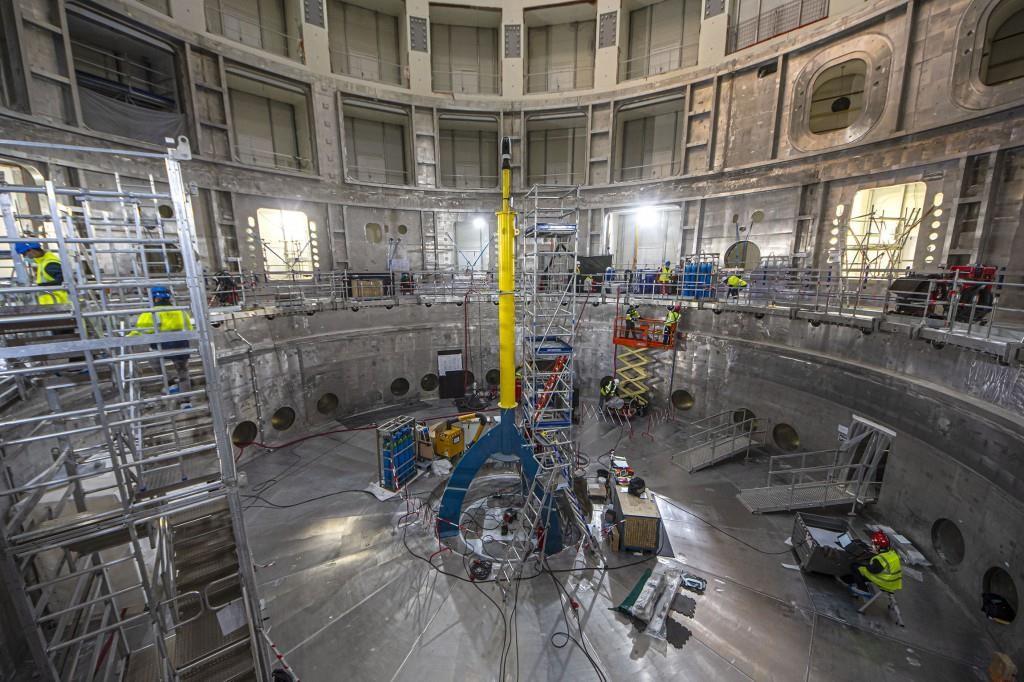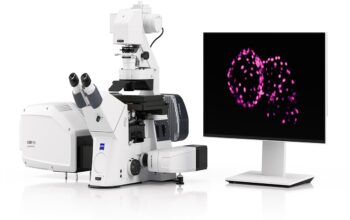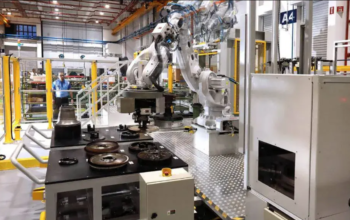METROLOGY Measurement activities are indispensable for the successful assembly of the ITER Tokamak.
Dimensional control of the components for ITER begins at supplier factories, where measurements are made during and on completion of component fabrication. Metrology engineers will re-inspect the principal components once they arrive at ITER and continue to control them throughout the assembly process to ensure the accurate positioning of components, assemblies and systems.
By the end of the process, metrologists will have recorded the exact as-built geometry of the machine—an invaluable source of information for future maintenance, modifications or revision.
On site, all measurement tasks require a fixed reference base (or datum) from which measurements can be made and calculated. For large-volume metrology applications, the reference base typically takes the form of a survey network that consists of a collection of target “nests” and/or instrument stations that have known geometry and computed uncertainty.
The primary survey network for ITER was installed and measured in 2010, and now provides a precise and accurate datum reference for construction of the ITER buildings and subsequent survey networks that are added within the buildings themselves. The accuracy requirements for each network vary according to the alignment tasks for which they are designed.
A wide range of metrology systems will be used during the assembly of the ITER machine such as laser trackers, total stations and photogrammetry, which will interface with dedicated software packages and measurement plans specific to the ITER requirements.
The amount of measurement data generated during machine assembly will be immense.
Optimization algorithms will be used to achieve the best possible configuration for machine operation by analyzing “as-built” geometry at each stage of the assembly and by modifying the alignment criteria to suit. This is especially important when defining the as-built magnetic axis of the machine and the subsequent alignment of components against this.
During the assembly phase and beyond, metrology processes ensure that the machine and its supporting systems are dimensionally compliant for the successful operation of the ITER machine.
Primary survey network
The primary survey network for the ITER site provides a global coordinate system for civil engineering works and the positioning of the buildings. It is based on 11 geodetic pillars that have been measured in relation to one another and to a wider GPS system, and which now provide a fixed reference base (or datum) from which more localized measurements can be made and calculated.
Tokamak Global Coordinate System
Inside of the Tokamak Complex, a vast matrix of reference “targets,” or fixed points, provides the physical manifestation of the global coordinate system. Metrologists will be able to access the overall coordinate system from any location by measuring a small number of local reference points. The accuracy of the network has been measured within a global uncertainty range of 0.2 to 0.4 mm, allowing installation contractors to align components to sub-millimetre accuracy.
Tokamak Pit Network
Inside of the concrete bioshield, target nests covering the full height of the walls are used to derive the vertical datum axis for machine assembly. As the pit becomes more crowded, and lower pit wall targets are progressively hidden from view, targets in the port cell galleries will maintain lines of sight and play an important role in measurement tasks.
Assembly Datums
As machine assembly progresses, the as-built geometry of core components serves as a reference for further alignment activities. The cryostat base will be aligned using the target nests of the Tokamak Pit Network; the toroidal field coils and cryostat lower cylinder will be aligned in relation to the as-built position of the cryostat base; and the coordinate frame of the 18 toroidal field coils will serve as reference for the final alignment of the vacuum vessel, the remaining magnet systems and the in-vessel components.
Assembly Phase II
Metrology will continue to play an important role after the assembly of the core machine, as in-vessel components in large numbers are installed during Assembly Phase II. Manufactured in plants around the world and shipped to ITER, several thousand components must be customized during assembly to achieve the demanding tolerances allocated to in-vessel systems. As a single example, the assembly of the blanket modules inside the vessel requires a survey of approximately 4,400 components; each one needs to be individually customized to deliver the required alignment.
ABOUT ITER :-
ITER (“The Way” in Latin) is one of the most ambitious energy projects in the world today.
In southern France, 35 nations* are collaborating to build the world’s largest tokamak, a magnetic fusion device that has been designed to prove the feasibility of fusion as a large-scale and carbon-free source of energy based on the same principle that powers our Sun and stars.
The experimental campaign that will be carried out at ITER is crucial to advancing fusion science and preparing the way for the fusion power plants of tomorrow.
ITER will be the first fusion device to produce net energy. ITER will be the first fusion device to maintain fusion for long periods of time. And ITER will be the first fusion device to test the integrated technologies, materials, and physics regimes necessary for the commercial production of fusion-based electricity.
Thousands of engineers and scientists have contributed to the design of ITER since the idea for an international joint experiment in fusion was first launched in 1985. The ITER Members—China, the European Union, India, Japan, Korea, Russia and the United States—are now engaged in a 35-year collaboration to build and operate the ITER experimental device, and together bring fusion to the point where a demonstration fusion reactor can be designed.
We invite you to explore the ITER website for more information on the science of ITER, the ITER international collaboration and the large-scale building project that is underway in Saint Paul-lez-Durance, southern France.
*Update 31 January 2020: The United Kingdom has formally withdrawn from the European Union and Euratom but has expressed strong interest in continuing to participate in the ITER Project. The terms of this new relationship will be negotiated during the transition period. Until a new arrangement is reached, the ITER Council has agreed that existing contracts, both with personnel and suppliers, will be honoured.
WHAT WILL ITER DO?

The amount of fusion energy a tokamak is capable of producing is a direct result of the number of fusion reactions taking place in its core. Scientists know that the larger the vessel, the larger the volume of the plasma … and therefore the greater the potential for fusion energy.
With ten times the plasma volume of the largest machine operating today, the ITER Tokamak will be a unique experimental tool, capable of longer plasmas and better confinement. The machine has been designed specifically to:
1) Produce 500 MW of fusion power
The world record for fusion power is held by the European tokamak JET. In 1997, JET produced 16 MW of fusion power from a total input heating power of 24 MW (Q=0.67). ITER is designed to produce a ten-fold return on energy (Q=10), or 500 MW of fusion power from 50 MW of input heating power. ITER will not capture the energy it produces as electricity, but—as first of all fusion experiments in history to produce net energy gain—it will prepare the way for the machine that can.
2) Demonstrate the integrated operation of technologies for a fusion power plant
ITER will bridge the gap between today’s smaller-scale experimental fusion devices and the demonstration fusion power plants of the future. Scientists will be able to study plasmas under conditions similar to those expected in a future power plant and test technologies such as heating, control, diagnostics, cryogenics and remote maintenance.
3) Achieve a deuterium-tritium plasma in which the reaction is sustained through internal heating
Fusion research today is at the threshold of exploring a “burning plasma”—one in which the heat from the fusion reaction is confined within the plasma efficiently enough for the reaction to be sustained for a long duration. Scientists are confident that the plasmas in ITER will not only produce much more fusion energy, but will remain stable for longer periods of time.
4) Test tritium breeding
One of the missions for the later stages of ITER operation is to demonstrate the feasibility of producing tritium within the vacuum vessel. The world supply of tritium (used with deuterium to fuel the fusion reaction) is not sufficient to cover the needs of future power plants. ITER will provide a unique opportunity to test mockup in-vessel tritium breeding blankets in a real fusion environment.
5) Demonstrate the safety characteristics of a fusion device
ITER achieved an important landmark in fusion history when, in 2012, the ITER Organization was licensed as a nuclear operator in France based on the rigorous and impartial examination of its safety files. One of the primary goals of ITER operation is to demonstrate the control of the plasma and the fusion reactions with negligible consequences to the environment.
WHAT IS FUSION?
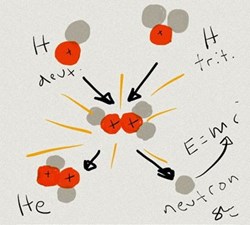
Fusion is the energy source of the Sun and stars. In the tremendous heat and gravity at the core of these stellar bodies, hydrogen nuclei collide, fuse into heavier helium atoms and release tremendous amounts of energy in the process.
Twentieth-century fusion science identified the most efficient fusion reaction in the laboratory setting to be the reaction between two hydrogen isotopes, deuterium (D) and tritium (T). The DT fusion reaction produces the highest energy gain at the “lowest” temperatures.
Three conditions must be fulfilled to achieve fusion in a laboratory: very high temperature (on the order of 150,000,000° Celsius); sufficient plasma particle density (to increase the likelihood that collisions do occur); and sufficient confinement time (to hold the plasma, which has a propensity to expand, within a defined volume).
At extreme temperatures, electrons are separated from nuclei and a gas becomes a plasma—often referred to as the fourth state of matter. Fusion plasmas provide the environment in which light elements can fuse and yield energy.
In a tokamak device, powerful magnetic fields are used to confine and control the plasma.
See the Science section for more on fusion and plasmas.
WHAT IS A TOKAMAK?
Visualization courtesy of Jamison Daniel, Oak Ridge Leadership Computing FacilityPower plants today rely either on fossil fuels, nuclear fission, or renewable sources like wind or water. Whatever the energy source, the plants generate electricity by converting mechanical power, such as the rotation of a turbine, into electrical power. In a coal-fired steam station, the combustion of coal turns water into steam and the steam in turn drives turbine generators to produce electricity.
The tokamak is an experimental machine designed to harness the energy of fusion. Inside a tokamak, the energy produced through the fusion of atoms is absorbed as heat in the walls of the vessel. Just like a conventional power plant, a fusion power plant will use this heat to produce steam and then electricity by way of turbines and generators.
The heart of a tokamak is its doughnut-shaped vacuum chamber. Inside, under the influence of extreme heat and pressure, gaseous hydrogen fuel becomes a plasma—the very environment in which hydrogen atoms can be brought to fuse and yield energy. (You can read more on this particular state of matter here.) The charged particles of the plasma can be shaped and controlled by the massive magnetic coils placed around the vessel; physicists use this important property to confine the hot plasma away from the vessel walls. The term “tokamak” comes to us from a Russian acronym that stands for “toroidal chamber with magnetic coils.”
First developed by Soviet research in the late 1960s, the tokamak has been adopted around the world as the most promising configuration of magnetic fusion device. ITER will be the world’s largest tokamak—twice the size of the largest machine currently in operation, with ten times the plasma chamber volume.
See the Machine section for more on the Tokamak and its components.
WHO IS PARTICIPATING?
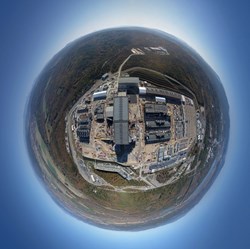
The ITER Project is a globe-spanning collaboration of 35 nations.
The ITER Members China, the European Union, India, Japan, Korea, Russia and the United States have combined resources to conquer one of the greatest frontiers in science—reproducing on Earth the boundless energy that fuels the Sun and the stars.
As signatories to the ITER Agreement, concluded in 2006, the seven Members will share of the cost of project construction, operation and decommissioning. They also share the experimental results and any intellectual property generated by the fabrication, construction and operation phases.
Europe is responsible for the largest portion of construction costs (45.6 percent); the remainder is shared equally by China, India, Japan, Korea, Russia and the US (9.1 percent each). The Members deliver very little monetary contribution to the project: instead, nine-tenths of contributions will be delivered to the ITER Organization in the form of completed components, systems or buildings.
Taken together, the ITER Members represent three continents, over 40 languages, half of the world’s population and 85 percent of global gross domestic product. In the offices of the ITER Organization and those of the seven Domestic Agencies, in laboratories and in industry, literally thousands of people are working toward the success of ITER.
The ITER Organization has also concluded non-Member technical cooperation agreements with Australia (through the Australian Nuclear Science and Technology Organisation, ANSTO, in 2016) and Kazakhstan (through Kazakhstan’s National Nuclear Centre in 2017); a Memorandum of Understanding with Canada agreeing to explore the possibility of future cooperation and a Cooperation Agreement with the Thailand Institute of Nuclear Technology (2018); as well as over 70 Cooperation Agreements with international organizations, national laboratories, universities and schools.
See the Members page for links to the seven Domestic Agencies.
WHEN WILL EXPERIMENTS BEGIN?
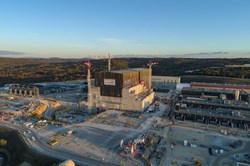
ITER’s First Plasma is scheduled for December 2025. That will be the first time the machine is powered on, and the first act of ITER’s multi-decade operational program. On a cleared, 42-hectare site in the south of France, building has been underway since 2010. The central Tokamak Building was handed over to the ITER Organization in March 2020 for the start of machine assembly. The first major event of this new phase was the installation of the 1,250-tonne cryostat base in May 2020. In the ITER offices around the world, the exact sequence of assembly events has been carefully orchestrated and coordinated. The successful integration and assembly of over one million components (ten million parts), built in the ITER Members’ factories around the world and delivered to the ITER site constitutes a tremendous logistics and engineering challenge. The ITER Organization will be carrying out the work supported by a number of assembly contractors (nine contracts in all). In November 2017, the project passed the halfway mark to First Plasma. (More here.) In July 2020, the project officially launched the machine assembly phase. (More here.) Today, project execution to First Plasma stands at 71.1 percent (October 2020 data). ITER Timeline 2005Decision to site the project in France2006Signature of the ITER Agreement2007Formal creation of the ITER Organization2007-2009Land clearing and levelling2010-2014Ground support structure and seismic foundations for the Tokamak2012Nuclear licensing milestone: ITER becomes a Basic Nuclear Installation under French law
2014-2021Construction of the Tokamak Building (access for assembly activities in 2019)2010-2021Construction of the ITER plant and auxiliary buildings for First Plasma2008-2021Manufacturing of principal First Plasma components2015-2023Largest components are transported along the ITER Itinerary
2020-2025Main assembly phase I2022Torus completion2024Cryostat closure2024-2025Integrated commissioning phase (commissioning by system starts several years earlier)Dec 2025First Plasma2025-2035Progressive ramp-up of the machine2035Deuterium-Tritium Operation begins
Throughout the ITER construction phase, the Council will closely monitor the performance of the ITER Organization and the Domestic Agencies through a series of high-level project milestones. See the Milestones page for a series of incremental milestones on the way to First Plasma.


